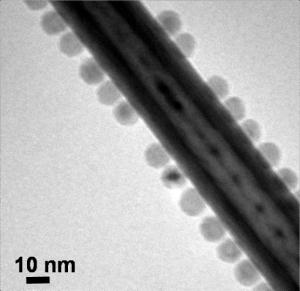
Inorganic chalcogenide (WS2) nanotubes have shown revolutionary chemical and physical properties that offer a broad range of applications. They are ultra-strong impact-resistant materials. This makes them excellent candidates for producing bullet proof vests, helmets, car bumpers, high strength glues and binders, and other safety equipment. The unique nanotubes are up to four to five times stronger than steel and about six times stronger than Kevlar, the nowadays most popular material used for bullet proof vests.
In addition to ballistic protection materials and polymer composites, WS2 nanotubes can be implemented in nanoelectronics, fuel cells, ultra-filtration membranes, and catalysts. Their optical properties allow various other applications in fields such as nanolithography or photocatalysis.
Up to now a major obstacle in the application of chalcogenide nanotubes has been their inherently inertness to chemical and biological modification and functionalization. Their potential use in composite materials might be greatly enhanced by improving the chalcogenide/matrix interface bonding. Scientists at Johannes Gutenberg University Mainz (JGU) devised a novel modification strategy based on metal oxide nanoparticles as universal vehicles for a reversible functionalization of WS2 nanotubes. The groundbreaking research conducted in the group of Wolfgang Tremel, Professor in the Department of Chemistry at JGU, and Dr. Ute Kolb at the Electron Microscopy Center was published in advance online on August 16 and will appear on the cover of the journal Angewandte Chemie.
The strategy underlying the reversible binding between chalcogenide nanotubes and metal oxide nanoparticles is based on "Pearson hardness," an elementary concept introduced more than 40 years ago to classify the Lewis acids and bases (especially the various commonly used metal ions and ligands) into three broad categories - hard, soft, and borderline. Metal oxides nanoparticles stick to the surface of chalcogenide nanotubes. As these metal oxide particles can carry many other functional molecules (e.g. polymers, biomolecules) as well, they can act as interfacial glue between the nanotubes and organic matter. This interfacial glue, however, can be detached purposely by the addition of substances that exhibit a stronger binding to the oxide nanoparticles than the WS2 nanotubes.
Hitherto all strategies of bonding to carbon or chalcogenide nanotubes were irreversible, i.e. once molecules have been bound they cannot be released again. The new, fully reversible attachment/detachment process will be applied in "smart materials" the toughness of which is reduced upon the influence of an external trigger. The findings will also provide a better understanding of fundamental friction issues, and - from a more practical point of view - offer a new tool for assembling nanotubes into devices and study the forces acting on them.
Further Information:
Jugal K. Sahoo, Muhammad N. Tahir, Aswani Yella, Thomas D. Schladt, Enrico Mugnaoli, Ute Kolb, Wolfgang Tremel:
Reversible Self-Assembly of Metal Chalcogenide/Metal Oxide Nanostructures Based on Pearson Hardness.
In: Angewandte Chemie International Edition; first published online: 16 August 2010, DOI 10.1002/anie.201000774
Source: Mainz University, Germany
Last update: 30.08.2010
Perma link: https://www.internetchemistry.com/news/2010/aug10/fully-reversible-functionalization-of-inorganic-nanotubes.php
More chemistry: index | chemicals | lab equipment | job vacancies | sitemap
Internetchemistry: home | about | contact | imprint | privacy
© 1996 - 2023 Internetchemistry
